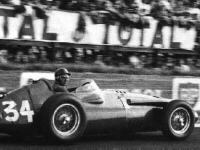The Maestro's swansong
Author
- Mattijs Diepraam
Date
- 8W July 1998 issue, offers are kindly accepted to extend the length of this article!
Related articles
- Maserati 250F - Classic Red, the Maserati 250F series, by Don Capps
Who?Juan Manuel Fangio What?Maserati 250F (self-entered) Where?Reims When?1958 French GP |
 |
Why?
This picture shows the end of an era and the dawn of another.
The 1958 French GP wasn't just 'Juan Manuel Fangio's last race'. The world of F1 was changing very rapidly in the late fifties and the Maestro, at the age of 47, must have felt he was part of the old state of affairs. In many ways 1958 was a pivotal year in the development of F1. After being the F1 centerpiece for the first eight years of the World Championship, large manufacturers like Alfa Romeo, Maserati, Lancia and Mercedes-Benz saw their domination rapidly slipping away in favour of the garagistes, small outfits which were totally focused on developing (or buying) a chassis fit with a customer engine.
It was also the year in which Britain made its final breakthrough as an F1 nation, with drivers like Hawthorn, Collins, Brooks, Hill and of course Moss sharing the limelight, and with Vanwalls, Coopers, BRMs and Lotuses taking the British Racing Green to the front of the grid. All these teams thrived on the garagiste way of doing things which had grown immensely popular in Britain because of its cheap and competitive F3 formula. Since the F1 regulations were swiftly evolving from massive front-engined manufacturer beasts with pre-war heritage to nimble mid-engined cars, the Brits were best prepared for F1's new era.
With Fangio and Maserati bailing out, the British takeover of F1 was ruthless. Only one Italian team survived the onslaught (you know who). But maybe that was because they adapted best to the British style and made no qualms of hiring British drivers, even winning the 1958 championship with Mike Hawthorn.
